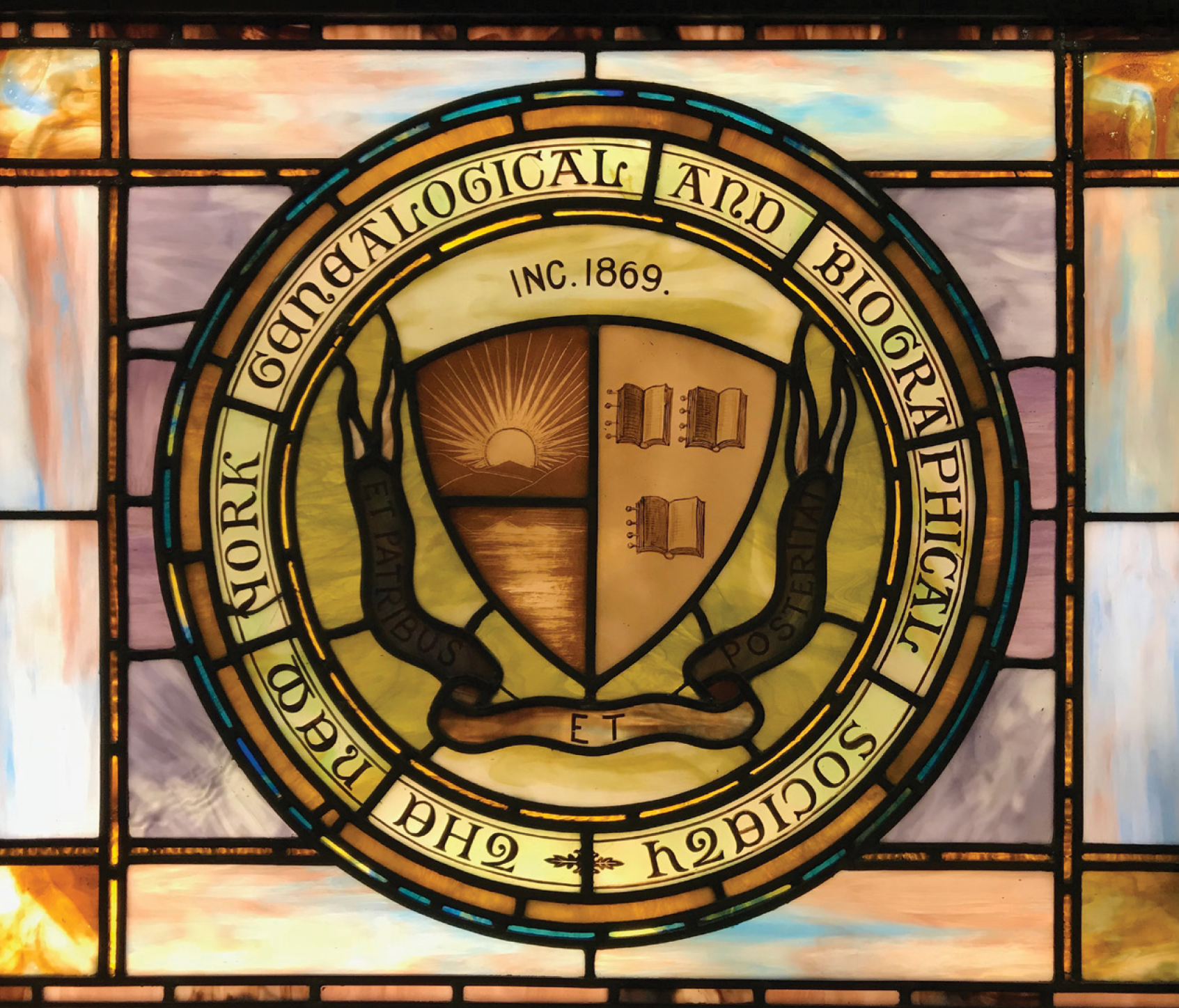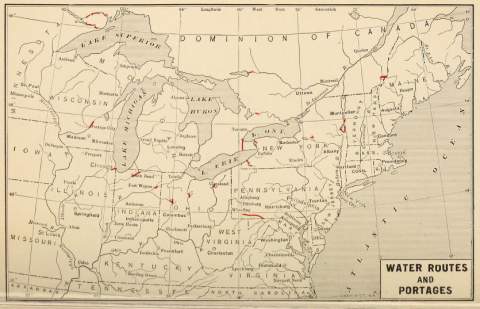This article originally appeared in the Summer 2008 issue of the New York Researcher and was authored by David McDonald CG®, who provides an overview of westward movement from New York throughout history. The reasons for westward movement vary by time period and population, and the route your ancestors may have taken on their westward journey depended heavily on what kind of transportation was available at that time in history. The contents of this article and the historical maps that accompany it (which did not appear in the original publication) will be of interest to anyone whose ancestors migrated from New York to the western or midwestern United States.
From the earliest days of European settlement in New York, there have been outward migrations toward what is now known as the Great Plains.
At the turn of the nineteenth century, the Astor Company had trappers and traders stretched across the continent, through the upper Great Lakes, across the Plains, and as far west as Astoria, Oregon. Though often thought of as a result of the Erie Canal's development in the 1810s and 1820s, westward migration happened even before the so-called "Wedding of the Waters" at New York City under the hand of DeWitt Clinton.
For the earliest migrants, traversing upstate regions was difficult and challenging work.

Just ask "Gentleman Johnny" Burgoyne, whose surrender at Saratoga was an early and vital victory for the Americans in the Revolution. Deeply forested in many places, with difficult rivers, mountains and the lack of even a blazed trail, those hoping to move westward were often defeated by the rugged upstate landscape. Prior to the opening of the Canal, many went north, through Canada and continued westward through modern Ontario and back into American territory in modern Michigan.
One should not claim only Europeans in this westward migration from the Empire State. Native Americans such as the Stockbridge and Oneidas were forced to make sequential moves from New England and New York, then to Wisconsin, and some finally to the early reservations established in Iowa.
Why New Yorkers went west
Why would folks choose to leave New York? For many, the colonies were becoming too crowded and inhabited. Perhaps this attitude is best summed up in the fictional accounting from How the West Was Won when Jimmy Stewart's character insists on moving on because there were too many settlers in Pennsylvania.
In the burgeoning towns and cities, the cost of living was something with which to be reckoned. In settled communities, land and buildings commanded high prices. Free or relatively inexpensive lands could be had if one was willing to move westward. At various points throughout the nineteenth century, military land warrants were issued to veterans and their surviving widows for service in the War of 1812. If your family included a veteran of that conflict, he may have received a warrant.

Recognize that though your solider or veteran was eligible for such a warrant, he may not have made the claim himself. Bounty-land warrants were transferable instruments that could be bartered or sold, and they often were. Sometimes the warrant was filed on behalf of family. Again, militia-aged and eligible men should be thoroughly examined for their place in the armed forces. If they served, bounty-land warrants should be sought at the National Archives in Washington.
In addition to bounty warrants, various types of homestead claims and purchases enticed movement to the Great Plains. The Homestead Act of 1862 provided a quarter section of land (160 acres) to those willing to live on and improve the parcel. After a five-year window, the title was cleared and the settler owned the land in question. If the settler was unwilling to wait that long, it could have been purchased outright even if originally claimed on a homestead basis. Veterans of the Civil War could reduce the five-year window by an amount equal to their time in service, provided they proved their service by a discharge certificate.
This provision, particularly, enticed a number of New York Irish, who in many cases had been substitutes for wealthier Yankees, to move westward to Kansas, the Dakotas and Nebraska in the years immediately after the war's close. If you suspect your forebear homesteaded and served, the veterans' and widows' roster of 1890 will be an important and valuable resource.
Recently, records of the Grand Army of the Republic related to veterans' deaths and burials have been published in book form. Dennis Northcott has published records from several states' commanderies, including Iowa, Kansas and Nebraska Civil War Veterans: Compilation of the Death Rolls of the Departments of Iowa, Kansas and Nebraska, Grand Army of the Republic, 1883-1948 (2007).

The Orphan Train phenomenon brought many natives of New York to the west. The work of a Plains farm required many hands. Orphans from the east helped to fill demand for laborers. Agents of various adoption and placement agencies established networks across the Midwest and Great Plains for the dispersal of orphaned youngsters. Brooklyn and New York City were both teeming with young waifs.
Catholic priests and orphanages were, in many cases, the agents who connected families interested in bringing children westward. Children could be pre-arranged based on eye and hair color, gender and age. Both the New York Foundling Society and the Children's Aid Society were instrumental in moving young orphans or abandoned children to the country's interior.
Utopianists of all types also looked to the west as a venue for establishing their communities. Henry S. Clubb of New York was secretary of the Vegetarian Settlement Society, which had designs to establish a community in central Kansas, not far from Fort Scott. A fascinating account of the society was written by Miriam Davis Colt, who went with her husband, parents-in-law, sister-in-law and two children from upstate New York via rail, steamboat and covered wagon in the 1850s. The community failed, the aged in-laws died in Kansas; her husband and son died on the journey back to the civilized world as well.
Political and religious motivations also encouraged individuals and families to move westward. Abolitionists of all varieties were drawn to Missouri and Iowa in advance of a heavy movement into Kansas, in hopes of turning the state slave or free. The Andover Band, a group of Congregationalist ministers, was brought together under the auspices of the American Home Missionary Society in hopes of establishing a network of churches across the Great Plains. They came into the Plains in the mid-1850s, sometimes under cover of darkness via back trails in order to avoid arrest and harassment by pro-slavery forces.

In addition to the so-called "northern" route to the Plains (Erie Canal, through the Great Lakes to Michigan or Wisconsin, then overland to Iowa and beyond), migrants headed west traveled down through New Jersey into Maryland and over the National Road to southern Illinois and onward to Missouri and points west. Still others crossed Pennsylvania and in the early era boarded boats down the Ohio River. By the 1840s, railroads were extensive throughout the upper Midwest, and one could travel as far as Chicago with some dispatch.
Researchers should be careful to note the progression of families over the course of the nineteenth century in their westward movement.

Street," by Jacob Riis, from his book
How the Other Half Lives, published
in 1890.
Take as an example, Orren Betts, who was born in Essex County in 1826. By 1832, his parents had removed to northern Ohio, bringing their eight children. His father, Jonathan, died there and several of the siblings married there as well. On the basis of his father's 1812 military service, his mother, Polly (Putnam) Betts, received a bounty land warrant for which she claimed 80 acres in central Iowa in 1855.
Three of the four Betts brothers and their youngest sister, together with their own families removed with the widowed Polly to Hardin County, Iowa. By the mid-1860s, Orren had filed homestead claims in Franklin County, Nebraska, for 160 acres. It was on this farm that he died in 1892, rarely living longer than 20 years in any one community before pulling up stakes and resettling further west.
In the last third of the nineteenth century, following the conclusion of the Civil War, Castle Garden and (later) Ellis Island were entry points for European immigrants to the United States.
Drawn to various states and cities by heavy advertising in Europe, family ties with earlier immigrants, and the prospect of free land, poor Europeans - and even some wealthier individuals - crossed the ocean and made New York their home, if only for a few years, before moving westward. In consequence, New Yorkers of various stripes and perspectives brought their points-of-view across the interior of the United States.
More Genealogy Reading
-
New York Catholic records online: What you need to know
-
Big news out of the New York State Family History Conference
-
Researching Irish ancestors in New York State
-
7 resources to get you started with genetic genealogy
-
Surprising facts about immigration to New York
-
Finding Birth, Marriage, and Death Records in New York State
About the New York Genealogical and Biographical Society

a registered 501(c)(3) organization devoted to
preserving, documenting, and sharing the history of
New York State families. Read more about our mission.
Since 1869, our mission has been to help our thousands of worldwide members discover their family's New York story, and there has never been a better time to join.
The cost of an Individual Annual Membership is less than six dollars a month, and includes the following benefits:
- Access to over 50 exclusive digital record sets covering the entire state of New York, including the fully searchable archives of The Record.
- A complimentary subscription to all of Findmypast's North American records, as well as U.K. and Irish Census records.
- Access to hundreds of expert-authored Knowledge Base articles and webinars to help you navigate the tricky New York research landscape.
- Exclusive discounts and advanced access to conferences, seminars, workshops and lectures to learn more about researching people and places across New York State.
To learn more or join us, please visit our member benefits page.
